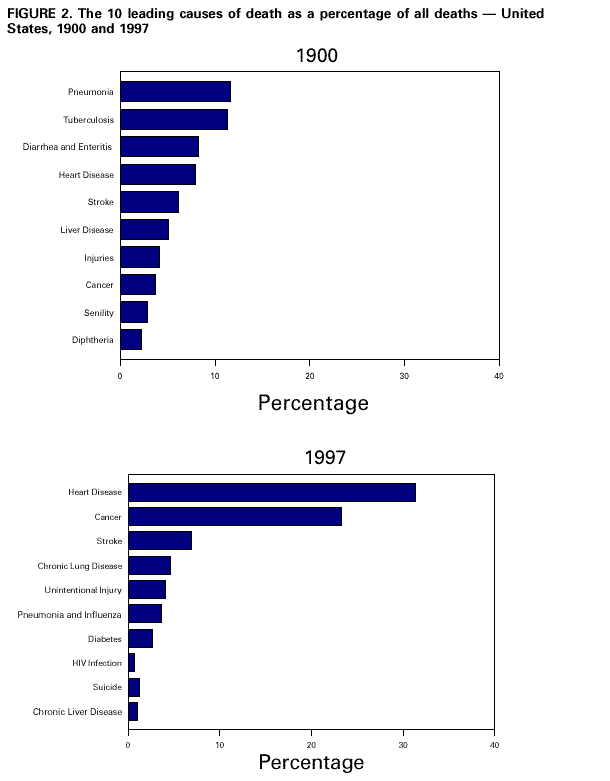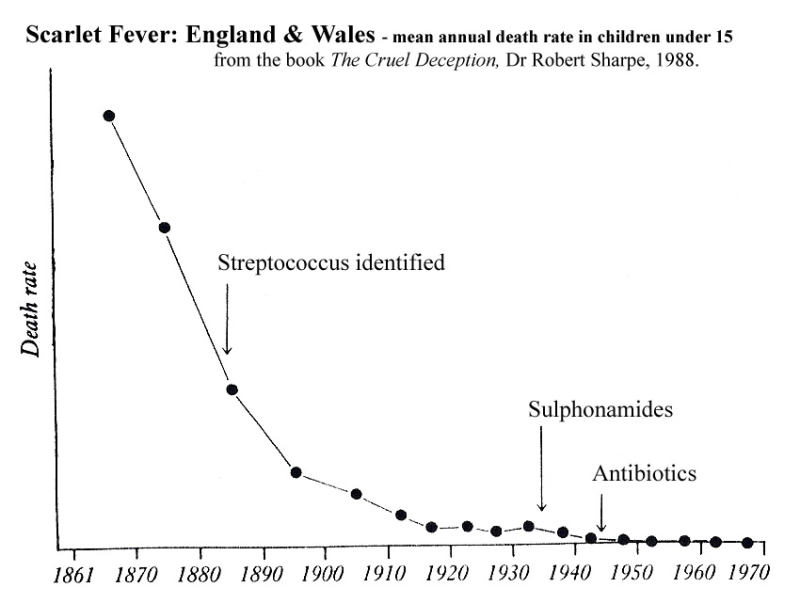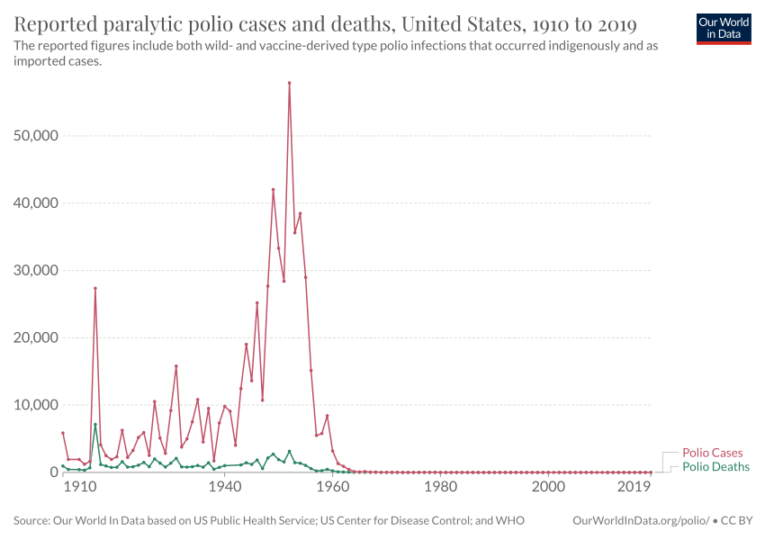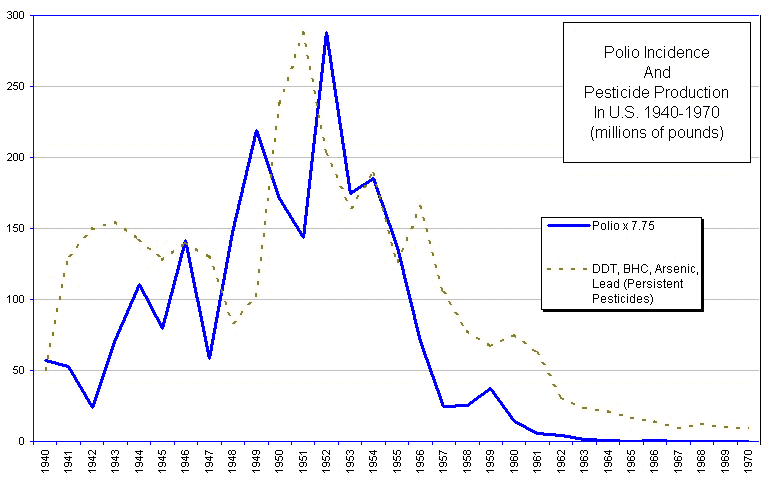Polio-3-chains.jpg

Illustration by Manuel Almagro Rivas, Wikimedia Commons / CC BY-SA 4.0
Type 3 poliovirus capsid, colored per chains.
In late July and early August, there were a collection of news reports about finding poliovirus in the sewage systems of some communities. On each broadcast we get the two standard messages that seem to come up frequently public health clips: (1) This could be really scary and (2) Make sure you got your polio vaccine. The question on a lot of minds: Is Polio making a comeback?1
At the very least this is going to stimulate a lot of conversations about vaccines. Here’s how a lot of these conversations go. One neighbor points out that there’s a lot of problems with vaccines. The other says, yes, but it has been one of the most effective public health measures in history. The two struggle to find “common ground.” They conclude the conversation with the observation that “vaccines can’t be all bad because at least they eradicated polio.”
Although this is a common occurrence and is characteristic of a commonly held set of opinions about polio and the polio vaccine, I am going to paint an entirely different picture. I am going to make a case for the following statements:
- Polio is not caused by the polio virus. It is not a contagious disease. Polio is instead caused by agricultural and industrial toxins that are capable of damaging the nervous system.
- The polio vaccine did not eradicate polio. Instead the details of the roll-out of the polio vaccine in 1954 clearly indicate that the polio vaccine INCREASED the incidence of polio.
- Polio was actually eradicated by a series of administrative changes that modified how polio was to be diagnosed. Polio was actually “re-defined” out of existence.
- Conditions/diseases that were commonly diagnosed as polio in 1954 are still around, but not quite as common today as they were back in the 1930’s, 1940’s, and 1950’s. Today they have different disease names that nobody cares about, but we dare not call them polio, for this would challenge the official narrative.
All of this deserves a closer look. First let’s look at a bit of history.
Is Polio Caused By a Polio Virus?
In the early 20th century, polio was one of the most feared diseases in industrialized countries, paralyzing hundreds of thousands of children every year.4 There were occasional cases of polio before 1900, but there were not enough to generate much medical interest or response.
It is an irony of medical history that the transformation of polio into an epidemic disease occurred only in those industrialized countries in North America and Europe that had experienced significant improvements in hygiene during the 19th and 20th centuries. That has led health experts to conjecture that the infection was common in earlier times but that people were exposed and infected (in typically unhygienic environments) at very young ages, when they were less likely to suffer permanent paralysis as an outcome. As hygiene improved, the certainty of young people of successive generations being exposed to the virus was gradually reduced, and in that new situation it was not long before enough susceptible children and adults had accumulated to allow epidemics to break out.5
Let’s see how that idea plays out.
The reliable part of this statement is that hygiene improvements – most notably water and sewer systems, were indeed reducing the incidence of contagious diseases throughout North America and Europe during this time. Here is a chart showing the leading causes of death at the beginning and the end of the 20th century.6
IsPolioComingBackFig1.png

Illustration courtesy of Daniel Cobb
These two graphs show the rather quick transition from infectious diseases to chronic conditions and degenerative diseases.
Here is a quote from Dr Robert Sharpe’s book The Cruel Deception:7
Mortality for virtually all the infections was declining before, and in most cases long before, specific therapies became available... The impetus to better health from the mid nineteenth century onward can therefore be directly traced to public health measures and social legislation that improved the living standards of working people... Higher wages and welfare benefits made it possible for the poor to eat properly and public health measures radically improved conditions in the densely-populated urban areas, particularly with the provision of clean water supplies, sanitation, sewerage and new housing... Susceptibility to the infections diminished radically as nutrition, housing, hygiene and general living conditions improved...
Link7 also contains graphs showing examples of this pattern for scarlet fever, tuberculosis, whooping cough (pertussis), measles, typhoid fever, diptheria, bronchitis, and general infant mortality. In the interest of avoiding an excessively long paper, I will only show only a few examples in this article.
Here is an example graph for scarlet fever.
IsPolioComingBackFig2.png

Illustration courtesy of Daniel Cobb
This graph demonstrates a common pattern for almost all infectious/contagious diseases. They were much worse in the 19th century. They started to decline in the late 19th century, continued to decline in the early 20th century, and became almost irrelevant by 1950.
So, if polio turned into an “infectious” epidemic because children didn’t get an early immunity from playing in unhygienic conditions, it was the only disease that followed this pattern. Most of the other diseases that declined were bacterial, but the list also includes measles, which is viral.
Here is a graph of the polio incidence in the USA.
IsPolioComingBackFig3.png

Illustration courtesy of Daniel Cobb
From this graph, it is easy to see the trend. I have looked up the numbers for 1952 to put this in better perspective.
...the polio outbreak in 1952 became the worst epidemic in our nation’s history. 58,000 cases were reported that year. Of those, 3,200 died and 21,000 were left with mild to disabling paralysis.8
So polio was an outlier. Almost all other infectious diseases were worse before the 20th century, gradually got better, especially during the later 19th and early part of the 20th century, and then became almost irrelevant by 1950. Polio followed an entirely different pattern. It was very uncommon in the 19th century, and them blossomed into a feared disease in the 1930-1950’s, before having its’ numbers drop to nearly zero a decade or so later. It would be the one infectious disease that would get worse in the 1930’s-1950’s time frame even after almost all others were experiencing significant improvements.
Polio was not acting like an infectious disease. The idea that immunity acquired in unhygienic environments could be lost when those environments were gradually cleaned up is a plausible idea, but it is a lot less plausible if it only applies to one disease in a context of dramatic changes to many diseases. Could something else explain this odd pattern?
What Does Medical Science Really Know About The Polio Virus?
In 1908 two scientists working in Austria, Karl Landsteiner and Erwin Popper, reported that they might have found an `invisible virus' that had caused these epidemics. They had made their discovery, they claimed, after making a suspension in water of minced diseased spinal cord from a nine-year-old victim of infantile paralysis. They had tested this noxious suspension by injecting one or two cups of it directly into the brains of two monkeys. The monkeys fell severely ill (as might have been predicted). One died and the other had its legs paralysed. The scientists then dissected the monkeys and found damage in their central nervous tissues similar to that found in human cases of infantile paralysis.
Today the World Health Organisation (WHO) still credits Landsteiner and Popper as having found the poliovirus with this experiment.
Why it does so is inexplicable.
The fluid they injected must have contained much human cellular debris, any toxins involved in the child's illness, and probably several kinds of viruses. So, it was no wonder the monkeys fell so desperately ill. Such a soup could in no way be considered an `isolate' of the tiny organism we now call a virus. It was also strangely non-infectious for a so-called virus, for the monkeys were not paralysed when made to drink it or when one of their limbs was injected with it, nor did they pass it on to other monkeys.2, 3
At the beginning of the 20th century, polio was clearly viewed as a non-contagious disease. There was an outbreak in 1892 in Massachusetts after lead arsenate pesticides were introduced.
The outbreak was investigated by Dr Charles Caverly, who reported that it was probably caused by a toxin rather than a micro-organism. Caverly said: `It usually occurred in families of more than one child, and as no efforts were made at isolation it was very certain it was non- contagious.'2
The competing theory was that polio might be caused by some kind of “germ” – possibly a virus. The early evidence was strongly in favor of a chemical toxin, but there was a problem. Industrial and agricultural interests have trade groups and contribute money to politicians. Viruses have no such advantages. No one would champion a virus. Public officials didn’t want to get into a fight with organized industry/agricultural groups, so the money naturally flowed to scientists investigating the viral possibilities. Within two decades the “virus” narrative was firmly in place.
In 1910 neonatologist L Emmett Holt reported: `Even five years ago if anyone had suggested that the disease under discussion (polio) was an infectious or contagious one, it would have been looked upon as a joke.'2
Is the Polio Virus Benign?
Because poliovirus, outside of a laboratory, is only found in humans20 , it is safe to conclude at least that there is no external reservoir for it. I follows then that if someone ‘gets’ poliovirus, they had to ‘get’ it from another human. The reports of poliovirus in the opening paragraph of this article that occurred without any known cases of polio in the area clearly indicates that poliovirus does not always cause disease. Claims have been made that 95% of all cases of polio are asymptomatic.21
The final answer to this question of whether poliovirus is benign must then come from evidence of infectious transmission or the lack thereof. I am persuaded by the statements in the previous several paragraphs that if the poliovirus can cause any disease at all, that disease certainly isn’t polio.
What Else Could Cause the Motor Neuron Damage Associated With Polio?
At this point I need to bring up one other important idea. The improvement in living conditions, hygiene and water/sewer systems is not the only major change in the 19th and 20th century in North America and Europe. This was a major time for the creation of new chemical toxins in industrial processes and the use of new chemical toxins as pesticides/herbicides. I might be useful to look into the possibility that some of these newly available toxins could have produced the symptoms of polio.
Lead
Lead had been around as a toxin for thousands of years. It is well known to create neurological problems, so you might be inclined to write it off as a suspect in a suddenly surging disease like polio. But one factor needs to be considered. During the period of the rise of polio, lead was being used for the first time as a pesticide that could be sprayed over large areas of cropland. Lead arsenate was first used in Massachusetts in 1892. The spray could also drift on the wind into homes.10
This was not the only “new” source of lead that would be able to affect a large collection of the unsuspecting population. A filling station in Dayton, Ohio, sold the first gallon of leaded gasoline in February 1923.9
Lead toxicity symptoms are progressively worse according to the resulting blood levels. The lower dose symptoms are almost all mental function problems. I believe that this is because this is what is most easily noticed. With slightly higher doses come some pain and irritability. With moderate blood levels the first signal of paralysis occurs. Constipation, which could be viewed as a paralysis of the large intestine, can occur at this point. It is only with high levels of lead exposure (70 micrograms/dl and up) that paralysis like you might see in polio becomes a common symptom.11
Over time, it became clear that environmental lead was a serious problem. Leaded gasoline was the primary fuel type produced and sold in America until 1975.10 Lead arsenate pesticides were banned gradually over the United States from 1950 to 1988.9
DDT
Extensive studies on the toxicity to mammals of the new insecticide, 4, 4'-dichlor- diphenyl-trichlorethane, commonly known as DDT, have shown that this substance is primarily a nerve poison, producing excitability, muscular tremors, clonic convulsions, and finally paralysis and death.'it also causes a leucocytosis, anaemia, changes in blood calcium, and fatty degeneration in the liver and kidneys. It is absorbed readily through the skin, particularly when dissolved in kerosene.12
Dr. Morton S. Biskind was one of the first medical writers to address the probability that the dramatic uptick in the polio epidemic post World-War II was directly attributable to the public availability of DDT. Here is an except of a Jim West document that summarizes his point of view:
He continues, bearing his exasperation in trying to make the obvious plain.
When the population is exposed to a chemical agent known to produce in animals lesions in the spinal cord resembling those in human polio, and thereafter the latter disease increases sharply in incidence and maintains its epidemic character year after year, is it unreasonable to suspect an etiologic relationship?13
Dr. Biskind’s efforts were largely ignored, but never factually refuted. The “official story” continued to be that polio was caused exclusively by a virus.
Other Pesticides
IsPolioComingBackFig4.png

Illustration courtesy of Daniel Cobb
My general statement is that polio was caused by a collection of toxins, all of which are known to affect the central nervous system. DDT is just one of them. The other named pesticide in this graph – Benzene Hexachloride is an organochloride insecticide that has similar neurotoxic properties to DDT, is several times more lethal than DDT, and was produced in similar quantities during the height of the 1950’s polio epidemic.18, 19 This graph shows all major pesticide production from 1940 through the major polio epidemic of the middle 1950’s. It is noteworthy that DDT was banned in the US in 1972, and Benzene Hexachloride was banned in 1966.
1954 - The Polio Vaccine Is “Ready To Test”
In 1954 he (Salk) tested this concoction on more than 400,000 US children. It was reported afterwards that `only' 112 of the children who received three jabs of his vaccine contracted polio within the next few months. Salk judged his experiment a success. But his safety-test results omitted all cases of children who were paralyzed after one or two doses of the vaccine - or within two weeks of taking the third dose.
These were counted as cases of polio in the non-vaccinated control group--and thus in my view cast doubt on the validity of his results, for it made it impossible to tell just what impact his vaccine had had.2
President Dwight Eisenhower and the whole national healthcare establishment were trumpeting the release of the polio vaccine as one of the greatest events since the end of World War II. Their reputations and their future careers were on the line. This vaccine HAD TO succeed.
Was the Polio Vaccine An Amazing Success Or An Embarrassing Failure?
Here is a sequence of events that should help you decide.
- APR 12 1954 – Salk vaccine pronounced “totally safe and effective” against polio
- APR 26 1954 – Cases of polio in vaccinated children reaches 200
- MAY 5 1954 – US Surgeon General suspends production of Salk vaccine
- MAY 10 1954 – Polio in vaccinated children blamed on manufacturing problems; Problems claimed to be fixed. Manufacturing begins again
- Late 1954 to 1955 – Boston reports 2000 cases of polio despite 130,000 childhood vaccinations. Prior year polio cases: 273; After vaccination campaign, polio doubles in New York State, and Connecticut triples in Vermont, and increased to five times as high in Rhode Island and Wisconsin.
The US health authorities absolutely needed to reduce the incidence of polio. To accomplish this, they redefined the diagnosis. It used to be paralytic symptoms for 24 hours. This was changed to 60 days. Because many polio cases self-resolve quickly, this caused a significant drop in polio statistics. Also, any case reported within 30 days of vaccination would be classified as pre-existing.
- July 1955 – Canada suspends distribution of Salk vaccine
- Nov 1955 – All Europe except Denmark has suspended distribution of Salk vaccine
- Jan 1957 – 17 US States had suspended distribution of Salk vaccine
- 1957 – NY Times reports that 50% of all polio between ages of 5 and 14 occurred after full vaccination
As of 1958, more administrative action was needed to rescue the failing polio vaccine program. Up to this time, inflammation of the meninges (the protective covering of the central nervous system) was diagnosed as “non-paralytic poliomyelitis.” In 1958, such cases were to be diagnosed as “meningitis.”
The incidence of meningitis soared as official polio cases declined, as the following table (compiled from national surveillance reports) shows.
| Non-paralytic polio cases | Aseptic meningitis cases | |
|---|---|---|
| 1951-1960 | 70,083 | 0 |
| 1961-1982 | 589 | 102,999 |
| 1983-1992 | 0 | 117,366 |
| (Jim West, Images of Poliomyelitis) | ||
Another substitute diagnosis also appeared in the Detroit epidemic in 1958 – acute flaccid paralysis. This, of course had similar artificial reductions in the incidence of polio.
Also, in 1958 another administrative remedy was used to “fix” the polio vaccine campaign. It had earlier been discovered that many people who had “polio” did not have any trace of the polio virus. In 1951 this was a “problem” for the vaccine researchers and it had to be kept quiet. But, by 1958, the vaccine proponents found a use for this information. A new regulation was put in place that polio could not be diagnosed without proof of the presence of the poliovirus. Because this was expensive and presented many technical challenges, it was often ignored, and other more convenient diagnoses were used instead.2
Changing Times – Changing Disease Names: Has The Incidence of Polio Actually Improved?
Meningitis, Acute Flaccid Paralysis, or even something a mild as a stiff neck that lasts for more than a day. These are conditions that, prior to the launch of the Salk polio vaccine in 1954, would have been diagnosed as polio. These conditions are still with us in very significant numbers. Officially, polio has been “eradicated,” but these conditions are all polio hiding in plain sight.
Based upon the original definition of polio, has polio become more or less of a health problem?
Total incidence for the United States are surprisingly hard to come by. For instance meningitis figures are highly available for bacterial meningitis disease (about 8600 per year). This is the portion of meningitis that the CDC is pleased to present – modern medicine with antibiotics has had a lot of success treating and suppressing bacterial diseases. But meningitis can also be brought about by viral, fungal, parasitic, and chemical toxin causes. These statistics I was not able to locate.14
The incidence of Acute Flaccid Myelitis that the CDC reports is in the low 100’s, and averages out to be less than 100 per year.15
There is also the problem of how accurate the statistics are. For example, meningitis is required to be reported to the CDC, but only if it is of the meningococcal variety. Acute Flaccid Myelitis is not required to be reported, consequently, the actual incidence of these are likely to be much higher.17
Therefore, I have to back away into general statements. I do believe that what was diagnosable as polio in 1954 is less prevalent today than it was back then. I also believe that the major reasons why are that DDT and Benzene Hexachloride have been banned in the USA, and lead compounds have mostly been removed from gasoline, paints, and the colorings of commonly used plates and mugs.
So, Is Polio Coming Back?
Not everything is looking up. Our environment is awash in new pesticides and industrial chemicals almost daily that government regulators are all too eager to approve for public use. If “polio” is making a comeback, this is where it will come from.
Here are a few ideas about what it would take to have polio to reappear. The same government bureaucracies that defined polio out of existence would have to choose to re-define it right back onto the front pages. The pharmaceutical companies would have to make yet another vaccine that would probably produce a flood of side effects while targeting a harmless virus. Both of them would have to choose to capitalize on the public’s long-standing fear of polio to generate another “public health emergency.” Also, the officials at various government health agencies would have to continue to suppress the medical opinions of those who would point the finger at chemical toxicity.
Does that make it sound unlikely......... or inevitable?
Citations
- CBS News, New York officials urge vaccinations after polio detected in wastewater.
- Janine Roberts, Polio, The Virus and the Vaccine.
- LF Haas, BMJ Journals
- History of Polio, Polio Global Eradication Initiative
- Encyclopedia Britannica, Polio Through History
- CDC, MMWR Weekly
- The Decline of the Infectious Diseases
- Argus Leader, Remembering the Polio Epidemic of the 1950’s
- Scott Oldham, How Leaded Gas Came to Be and Why We Don’t Miss It
- Lead Action News, The Global Problem of Lead Arsenate Pesticide
- ATSDR, Lead Toxicity
- VB Wigglesworth - British medical journal, 1945, Volume 11.
- Jim West, Pesticides and Polio
- NIH, Meningitis and Encephalitis Fact Sheet
- CDC, AFM Cases and Outbreaks
- CDC, Guillain-Barre Syndrome
- Medline Plus, Reportable Diseases
- Jim West, Images of Poliomyelitis A Critique of Scientific Literature, Townsend Letter For Doctors and Patients, Issue 203, June 2000
- MedicinesFAQ, Benzene Hexachloride
- Wikipedia, Poliovirus
- Grunge, The Messed Up History of Polio


